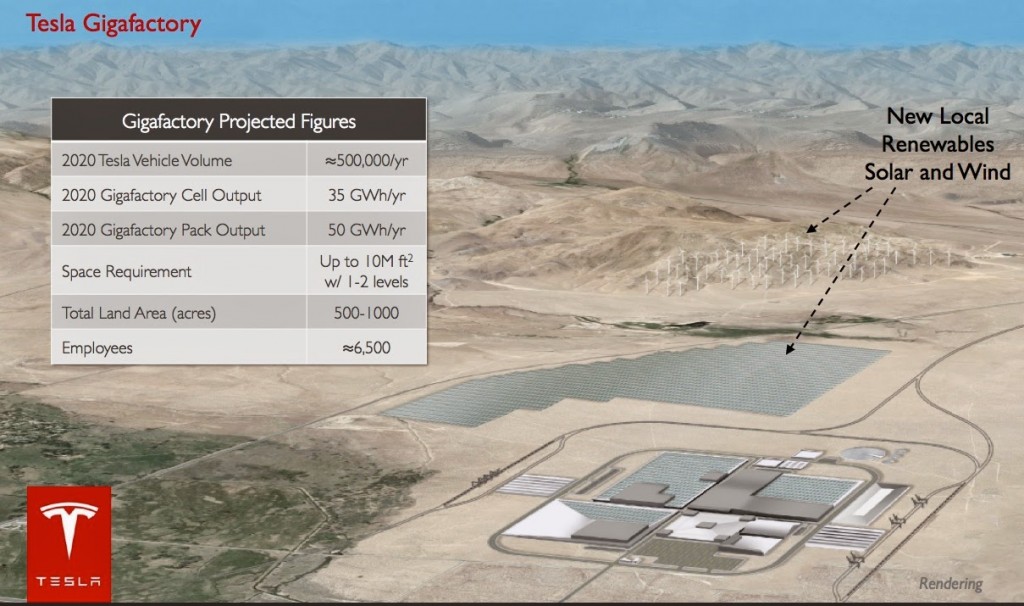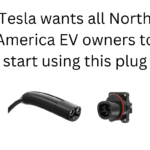Tesla Motors’s model for the Gigafactory is, as is usual for Tesla, unusual. The factory will be wholly owned by Tesla, but the plan is that it will be like an “industrial park under one roof” with several companies all performing their bits, but working together on the goal of producing and recycling battery packs. Today’s quarterly analyst call with Tesla Motors talked a lot about the Gigafactory, one aspect of which is its operation as a cooperative operation between several companies.
Tesla and Panasonic have signed a Letter of Intent under which Panasonic will be the cell supplier. They’re meeting regularly to go over issues and hope to sign the final agreement by the end of the year.
Panasonic will be the only company in the Gigafactory producing battery cells. But the finished product, battery packs, contains a lot more than the battery cells.
For example, the raw precursor materials will be processed on-site under the same roof as Panasonic.
Tesla’s role is to control the overall design, and assembling completed battery packs and modules. Panasonic will produce the cells, with a bunch of other companies on-site producing precursor materials including cathode, anode, separator, and so on. The cathode, anode, electrolyte(s) and separator are the core constituents of battery cells.
The targeted capacity for cell production at the Gigafactory is 35 gigawatt-hours, while the battery pack capacity is 50 gigawatt-hours. Therefore they’ll bring in cells from other cell factories in the world. Expect a lot of those will be Panasonic cells. But Panasonic may be unable to meet the demand, and there will be other suppliers as well.
A big goal for Tesla is a 30% cost reduction in cost per kilowatt-hour. Battery pack cost is perhaps a quarter the cost of an electric car. Moving towards a mass produced low cost car, the Gen III Tesla, battery pack cost must fall considerably.
Musk explained that as Tesla explored the cost structure in the battery pack supply chain, there’s much room for improvement through innovation.
The example he gave is having talked with mining companies to secure a source of Nickel at lower cost. It seems the mining companies rarely get direct contact from customers, but instead work through commodities markets. What Tesla plans instead is to directly purchase materials from mining companies. Rather, to work ingenuously with these companies on an optimized process of converting raw materials to finished goods.
Musk didn’t explain precisely what that meant. It might mean receiving raw ores at the gigafactory, and smelting on-site, or it might mean working directly with a smelting shop to directly produce precursor components. The takeaway, however, is that Tesla is going into the depths of the supply chain to optimize the cost.
The Gigafactory design should itself optimize costs by co-locating partner companies under one roof. The chance to work fluidly among partners on optimizing production processes should be there. Also, shipping precursor components from one corner of a factory to another should cost a lot less than shipping them across whole continents.
- Highway design could decrease death and injury risk, if “we” chose smarter designs - March 28, 2015
- GM really did trademark “range anxiety”, only later to abandon that mark - March 25, 2015
- US Government releases new regulations on hydraulic fracturing, that some call “toothless” - March 20, 2015
- Tesla Motors magic pill to solve range anxiety doesn’t quite instill range confidence - March 19, 2015
- Update on Galena IL oil train – 21 cars involved, which were the supposedly safer CP1232 design - March 7, 2015
- Another oil bomb train – why are they shipping crude oil by train? – Symptoms of fossil fuel addiction - March 6, 2015
- Chevron relinquishes fracking in Romania, as part of broader pull-out from Eastern European fracking operations - February 22, 2015
- Answer anti- electric car articles with truth and pride – truth outshines all distortions - February 19, 2015
- Apple taking big risk on developing a car? Please, Apple, don’t go there! - February 16, 2015
- Toyota, Nissan, Honda working on Japanese fuel cell infrastructure for Japanese government - February 12, 2015












